- Submissions

Full Text
Novel Techniques in Nutrition and Food Science
Biophoton Generators Enhance Germination, Preserve Produce and Boost Fermentation: A New Frontier in Quantum Nutrition and Agriculture
James Z Liu*, Helen Y Gu and Devin R Liu
First Institute of All Medicines, USA
*Corresponding author:James Z Liu, First Institute of All Medicines, New Castle, Delaware, USA
Submission: July 21, 2025;Published: August 04, 2025

ISSN:2640-9208Volume8 Issue 4
Abstract
Biophoton energy, coherent light emitted by biological systems, has emerged as a novel force in optimizing agricultural processes. This article presents compelling multi-domain findings on the biological benefits of strong biophoton fields applied across plants, animals, produce, beverages and microbial systems. In plant studies, seeds exposed to six Tesla Bio Healers showed significantly faster germination and more vigorous growth compared to controls. Animal models, including chickens, cats, dogs and horses, demonstrated improved coat quality, alertness and vitality after just two weeks of biophoton exposure. In food preservation experiments, fruits and vegetables maintained or increased their life force energy over five days, while untreated controls declined. Commercial beverages such as spring water, juice and nutritional supplements exhibited dramatic gains in life force energy-up to 100K units-after 48 hours in a biophoton field, with the elevated energy maintained for months. Remarkably, fermentation activity surged after biophoton exposure, with revived bubbling in previously inactive tanks, higher alcohol yields and stable batch quality reported by small-scale producers. Together, these results suggest that biophoton technology offers a sustainable, non-chemical and non-invasive approach to enhancing vitality, efficiency and quality across agricultural and biological systems. The cross-species, cross-function evidence points toward a new paradigm-quantum agriculture, in which light-based bioenergetics may be harnessed to optimize productivity, resilience and energetic integrity in food and farming. These findings invite collaboration across agricultural sciences, biotechnology and regenerative systems to translate this emerging technology into scalable real-world applications.
Keywords:Biophoton energy; Quantum nutrition; Quantum agriculture; Plant vitality; Food preservation; Fermentation enhancement; Animal wellness
Introduction
Biophotons are ultra-weak photon emissions spontaneously emitted by all living systems. First reported by Gurwitch in the 1920s and later confirmed by modern photon detection technologies, these emissions are now understood as byproducts of oxidative metabolic processes, including mitochondrial respiration and reactive oxygen species activity [1,2]. Importantly, biophotons are not random noise; mounting evidence suggests they may play a role in cell-to-cell communication, DNA regulation and systemic energy balance [3,4]. Recent studies have explored the effects of externally applied biophotonic fields, engineered light emissions from specialized materials-on biological systems. Such fields have been reported to influence cell proliferation, tissue regeneration, microbial activity and even neural signaling [5,6]. This study builds on that body of work, investigating whether exposure to strong biophoton-generating devices can enhance physiological processes across plant, animal and microbial systems. To assess biological vitality, one traditional and increasingly revisited approach is the Bovis scale, introduced by Antoine Bovis and later refined by Dr. Oscar Brunler. Originally designed to assess the energetic quality of foods and environments through dowsing and radiesthesia, the Bovis scale has been interpreted in modern contexts as a proxy for measuring subtle energy fields or life force-concepts that resonate with emerging quantum biology frameworks [7]. Measurements are reported in Bovis Units (BU), with higher values corresponding to increased life-supporting potential. This model parallels the principle of energetic homeostasis, wherein organisms seek equilibrium with their environment-gaining vitality from high-energy exposures and losing vitality in depleted contexts [8].
This report presents results from four independent experiments
designed to evaluate the cross-system biological effects of strong
biophoton fields:
A. Plant Germination and Growth: Seeds grown on a table
above six Tesla BioHealers for Adults were compared to
control seeds grown without biophoton exposure, assessing
germination speed and growth robustness.
B. Animal Vitality: A chicken, cat and dog were each exposed
to two Tesla BioHealers for Pets near their sleeping areas, while
a horse received biophoton input via Tesla Med-Bed Generators.
Vitality indicators such as fur or feather quality and behavioral
energy were recorded.
C. Life Force in Produce: Fruits and vegetables were placed
inside a regular refrigerator and monitored over five days using
a Bovis Units and verified with a Canadian-made lifeforce meter.
Results were analyzed to assess the retention or enhancement
of life force energy under biophoton exposure.
D. Energizing commercial beverages. Seven common
commercial beverages were energized inside of the strong
biophoton field generated by 8 large biophoton generators.
Results were analyzed to assess the enhancement of life force
energy under biophoton exposure.
E. Fermentation Efficiency: A standard alcohol fermentation
tank was monitored for bubbling activity before and after the
placement of a biophoton generator nearby. Increased bubbling
was used as a visual proxy for elevated microbial metabolism.
The impact of biophoton energy on tea fermentation was also
assessed.
Together, these experiments aim to test the hypothesis that biophoton energy can support and stimulate biological function across diverse domains-from seedling development to animal vitality and microbial fermentation-while also preserving the nutritional and energetic quality of perishable foods.
Materials and Methods
Plant Material and Experimental Setup: Identical seeds of great
northern beans, soybeans, red kidney beans, green onion were used
for both the control and biophoton-treated groups. Seeds were
placed in identical trays with equal amounts of soil and water and
kept under the controlled environmental conditions (temperature,
humidity and light exposure).
a) Control Group: Seeds were grown without biophoton
exposure.
b) Biophoton Group: Seeds were continuously exposed to
a biophoton generator during the germination and growth
period.
The experiment was conducted over 15 days and documented
in three stages:
A. Baseline (10-27-2024): Initial planting with no visible
germination.
B. Germination Stage (11-03-2024): Emergence of sprouts
was photographed and compared.
C. Growth Stage (11-11-2024): Final plant height and
density were visually evaluated.
Photographs were taken under consistent lighting and angles for comparison, as shown in (Figure 1).
Figure 1:Experimental setup for evaluating the effects of biophoton exposure on plant germination and growth.
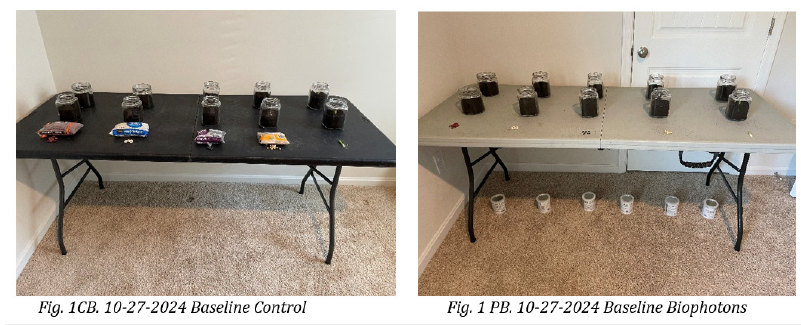
This image shows the initial setup of the experiment, in which
identical jars containing bean seeds were placed on two separate
tables under identical environmental conditions. For the Biophoton
Group, six Tesla BioHealers for Adults were positioned underneath
the table to emit continuous biophotonic energy during the
germination and growth period. The Control Group was placed on
a similar table without any biophoton generators. This side-by-side
arrangement allowed for a direct comparison of growth outcomes
influenced solely by the presence or absence of biophotonic
exposure. Biometric Energy Measurement (Bovis Scale). To
evaluate the energetic quality of the experimental environment,
we referenced the Bovis Scale, a unit system developed by
Antoine Bovis and later refined by Dr. Oscar Brunler. Originally
designed to measure “vital rays,” the scale was later interpreted as
corresponding to quantum emissions of light. The scale uses Bovis
Units (BU) to describe the energy or vitality level of substances or
environments:
a) Low BU values indicate energy depletion or stagnation.
b) High BU values suggest an energizing and life-supporting
environment.
The biophoton generator used in this study was precharacterized as producing a high Bovis Unit field, indicating its potential to stimulate biological systems. According to the principle of energetic equilibrium, when a living body encounters a low-energy environment (e.g., stagnant water), it donates energy and feels depleted. Conversely, exposure to high-energy fields is expected to restore or enhance vitality. Animal Vitality Observation. In the past 5 years, over 1000 pet owners reported that their pets have become healthier and showed much higherlevel energy than before exposing their animals to biophoton generators. This experiment was to validate the user-reported real-world evidence. The observations of animal health were conducted as a practical indicator of environmental bioactivity. As commonly practiced by farmers and pet owners, animal vitality was assessed qualitatively through indicators such as mobility, responsiveness and behavioral patterns. These observations serve as supportive context for the potential broader biological effects of biophoton exposure. Energizing commercial beverages. Seven common commercial beverages were placed inside of the strong biophoton field generated by 8 large biophoton generators for 48 hours. Life force energy of these beverages was analyzed to assess the enhancement of life force energy under biophoton exposure. Fermentation Monitoring. To assess the potential impact of biophoton energy on microbial activity, fermentation performance was measured using a standard alcohol meter, a tool widely used to monitor ethanol concentration in fermentation tanks. The increase in alcohol proof after exposure to the biophoton generator was taken as a proxy for enhanced fermentation activity, consistent with stimulated metabolic output by the yeast organisms. A similar experiment was conducted to evaluate the effects of a biophoton generator on kombucha fermentation. Four fermentation batches were prepared for both the control and treatment groups under identical conditions. All batches were placed in a temperaturecontrolled room maintained between 65 and 68 °F (18.3 to 20 °C). The pH of each batch was monitored daily over a 10-day period. At the conclusion of the experiment, the final kombucha products were assessed for pH levels and flavor characteristics.
Results
Plant germination and growth enhancement (Figure 2)
As shown in Figure 2CG1, seeds of red kidney beans exposed to the biophoton generator demonstrated accelerated germination and more robust vegetative growth compared to the control group. By Day 7, the biophoton-treated seeds (Figure 2PG1, 2PG2, Great Northern Beans) exhibited higher germination rates and more developed shoots than the Controls (Figures 2CG1, 2CG2). By Day 15, plants in the biophoton group (Figure 2PW2) appeared taller, denser and more vibrant, indicating enhanced physiological development, while the control group (Figure 2CW2) showed comparatively less growth. This figure demonstrates the accelerated germination and enhanced vegetative growth of bean plants cultivated above six biophoton generators positioned under the table. Seeds were planted in identical jars with uniform soil and watering conditions. Visual observations show that plants exposed to biophoton energy developed faster and exhibited taller, more vigorous growth compared to typical growth rates under ambient conditions. The enhanced development suggests a stimulatory effect of biophotonic energy on early-stage plant physiology.
Figure 2:Effect of biophoton exposure on plant germination and growth using six biophoton generators placed beneath the growth table.
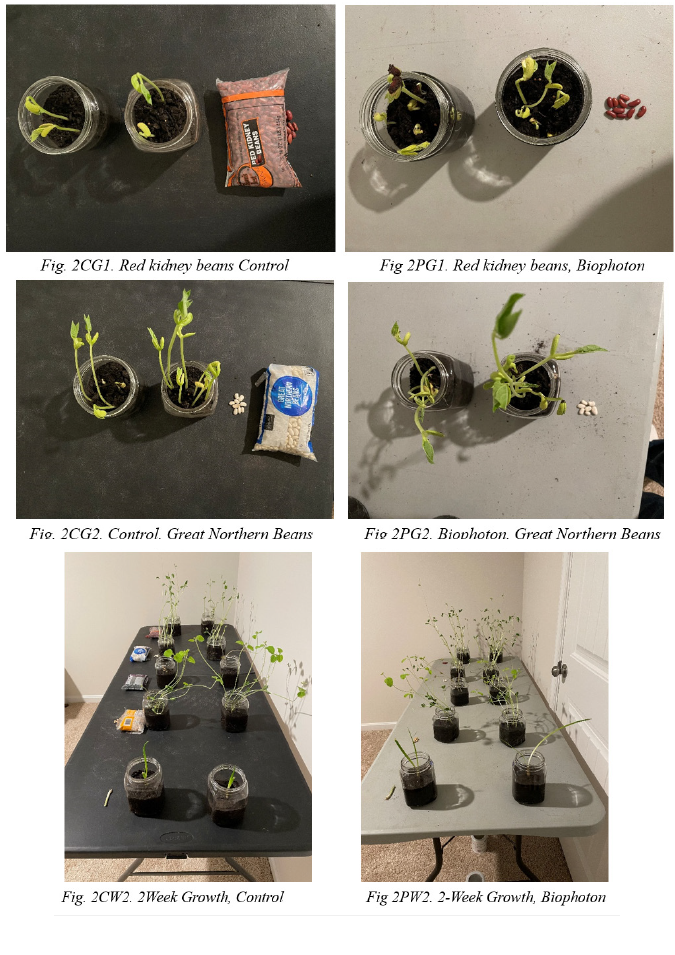
Animal vitality improvements (Figure 3)
Figure 3 presents photographic comparisons of a chicken, a cat, a dog and a horse at baseline and after 2 weeks of continuous biophoton exposure relatively propositional to their body sizes. Across all four species, notable improvements were observed in external appearance and vitality. Feathers and fur appeared shinier and denser and the animals displayed more alert and energetic behavior. These changes suggest enhanced systemic vitality is likely influenced by improved circulation, cellular function, or reduced oxidative stress. These changes were very similar to the feedback from over 1000 pet owners and clinical observations in human adults [9-13]. This figure presents visual comparisons of four animal species-chicken, cat, dog and horse-before and after 2 weeks of biophoton exposure. Two Tesla BioHealer for Pets devices were placed beside the sleeping areas of the chicken, cat and dog, while the horse was exposed to Tesla Med-Bed Generators in its resting stall. Photographs taken at baseline and post-treatment show noticeable improvements in coat or feather quality, posture, alertness and overall energy. These findings suggest that proximity to strong biophoton fields may enhance systemic vitality and external appearance in a range of animal species.
Figure 3:Improved vitality in animals following 2-week exposure to biophoton generators placed near sleeping areas.
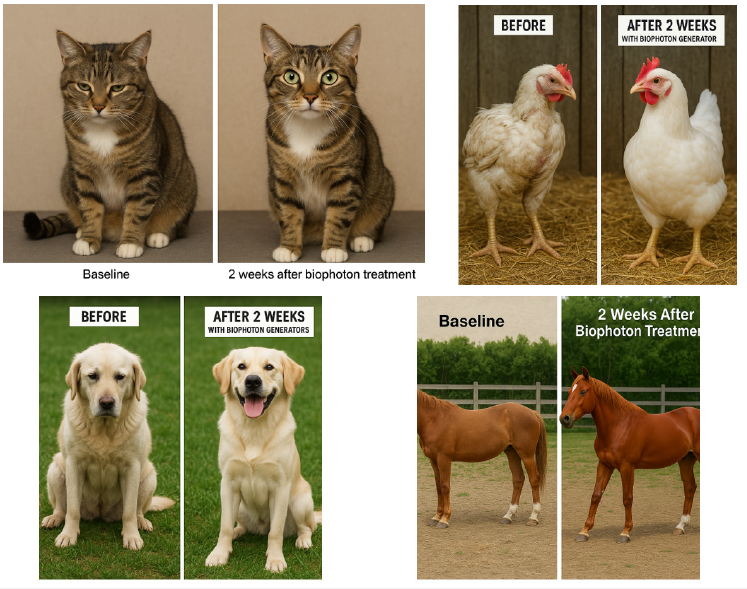
Life force retention in fruits and vegetables (Table 1)
Table 1 displays the measured life force energy (in Life Force
Units, LFU) of fruits and vegetables using a Canadian-manufactured
life force meter. Results show that:
A. In the control group, the total LFU decreased from 105K
to 90K over five days, indicating degradation of energetic quality.
B. In the biophoton-treated group, the total LFU was
maintained at 105K even after five days, with several items (e.g.,
red grape, white grape, blueberry, banana) showing an increase in
measured energy.
C. The nutritional value of fresh fruits and vegetables are
highly correlated to their life force energy.
These findings suggest that biophoton exposure preserved or may enhance the life energy of fresh produce, delaying energy, nutrients and possibly biochemical degradation. Hence, the nutritional value of these fruits and vegetables is preserved.
Table 1:Life Force Units of the Fruits and Vegetables Were Preserved by Biophoton Generators.
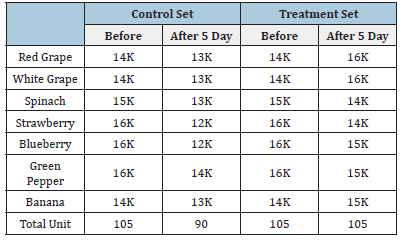
Energize commercial beverages (Table 2)
Table 2:Life Force Units of the Commercial Beverage Impacted by Biophoton Field.
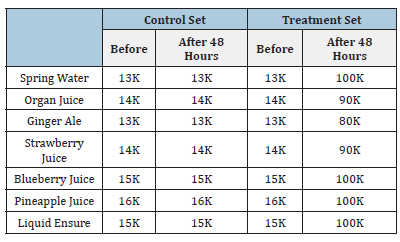
It was designed to determine if the ready-to-drink nutritional products could be further enhanced in terms of their life force. Commercially available spring water, non-alcoholic beverages, liquid nutrition (Ensure®), were placed inside of the strong biophoton energy field for 48 hours in the normal room temperature. Previously, we determined that extension to 72 hours of biophoton exposure of these food items did not further increase their life force energy. Life force energy was measured before and after biophoton energization (Table 2).
Table 2 presents the measured Life Force Units (LFU) of seven commercially available beverages before and after 48 hours of exposure to a biophoton-generating field, compared to control beverages kept under identical conditions without biophoton treatment. In the control set, all beverages maintained their initial LFU values over 48 hours, showing no energetic change. In contrast, the treatment set demonstrated a dramatic increase in LFU across all beverages. For example, spring water increased from 13K to 100K LFU, blueberry juice from 15K to 100K and Liquid Ensure from 15K to 100K. Other beverages such as ginger ale, strawberry juice and pineapple juice also showed significant energetic enhancement, with final LFUs ranging from 80K to 100K. These results suggest that exposure to a strong biophoton field can markedly elevate the energetic vitality of diverse liquid products, even within a short 48-hour timeframe. This enhancement was not observed in the untreated controls, indicating a potential role for biophoton energy in improving or preserving the subtle energetic quality of consumable liquids. The elevated energy of the 7 drinks maintained for about 80% of the peak energy three months after energization (Data not shown). Enhanced Fermentation Activity- Wine (Figure 4).
Figure 4:Enhanced fermentation activity observed after placement of a biophoton-generating device next to an alcohol fermentation tank.
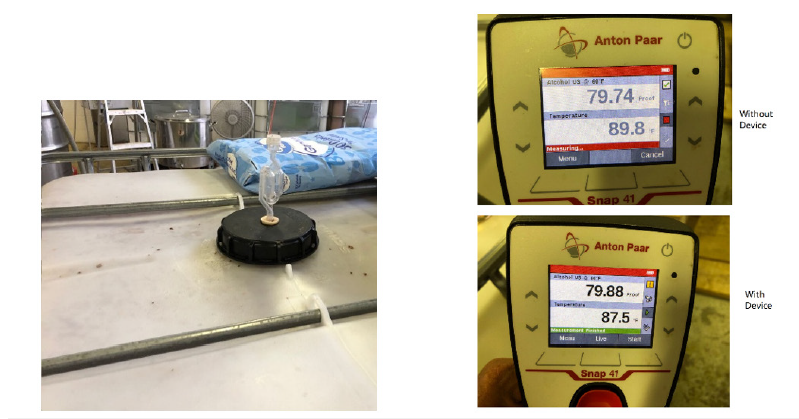
Figure 4 documents the observed increase in fermentation activity following the placement of a biophoton-generating device next to a fermentation tank that “already completed the fermentation” since no more carbon dioxide comes out. Visual evidence shows the reappearance of active bubbling, indicating higher carbon dioxide release and metabolic activity of the fermenting microorganisms. The alcohol readings were also higher than before placing the biophoton generator next to the tank. This suggests that biophoton exposure may stimulate microbial fermentation efficiency, potentially improving yield and processing time in alcohol production. The local small business owner who participated in this experiment reported that since he was provided with that large biophoton generator, he does not need to buy any new yeast and his beverage has a stable flavor among all batches, in addition to the 20% additional alcohol yield. Therefore, his products are very much liked by his customers. This photograph captures visible bubbling within the fermentation tank following the introduction of the biophoton-generating device (one Tesla MedBed Generator) adjacent to the tank. The increased rate of gas release and high alcohol reading indicates elevated microbial activity and a more vigorous fermentation process. These visual changes suggest that exposure to biophotonic energy may stimulate metabolic function in fermenting organisms, resulting in improved efficiency and yield during alcohol beverage production.
Enhanced fermentation activity- tea (Table 3 and Figure 5)/
Kombucha, a fermented tea, offers several potential health benefits, primarily due to its rich probiotic content and antioxidant properties. It may improve gut health, boost the immune system, aid in digestion and potentially help with blood sugar management and heart health. This test is to determine if a strong biophoton generator could speed up tea fermentation. The results were summarized in Table 3.
Table 3:Impact of Biophoton Generator on Tea Fermentation.

Figure 5:Enhanced fermentation activity in kombucha following exposure to a biophoton-generating device. Fermentation vessels placed adjacent to the biophoton generator exhibited accelerated acidification and increased effervescence compared to control vessels. These visual and measurable differences suggest that biophoton exposure may stimulate microbial activity during tea fermentation.
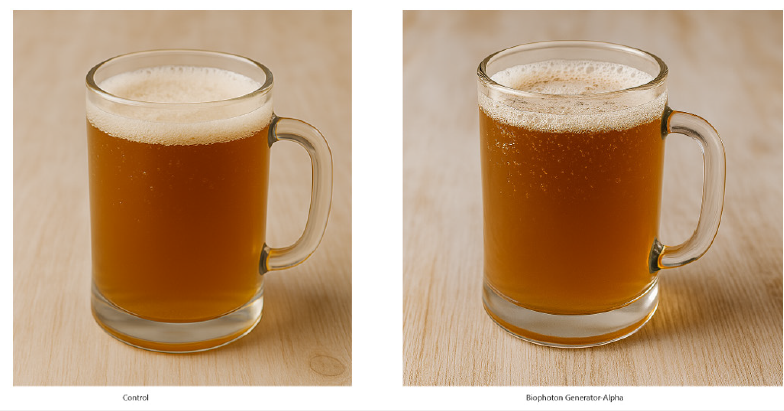
Table 3 demonstrates a significant acceleration in tea
fermentation when exposed to a biophoton generator. The treatment
group reached the target pH of 3.5 in just 4 days, compared to 8 days
in the control group-indicating a twofold increase in fermentation
speed. Despite the accelerated process, the sensory evaluations at
the end of fermentation were consistent across both groups, with
comparable flavor, aroma and acidity levels rated as acceptable.
This suggests that biophoton exposure enhances fermentation
efficiency without compromising quality. Possible mechanism of
fermentation enhancement. Biophoton generators are designed
to emit strong intensity, coherent light in the red to near-infrared
spectrum (typically 500-1000nm). These biophotons may interact
with biological systems through non-thermal, quantum-level
mechanisms that influence molecular vibrations, enzyme dynamics
and electron transport processes. In the context of fermentation,
possible mechanisms include:
A. Enzyme Activation: Enzymes involved in glycolysis
and alcohol fermentation (e.g., alcohol dehydrogenase)
may experience enhanced catalytic activity in the presence
of coherent biophoton fields, leading to increased ethanol
production or stabilization post-fermentation.
B. Cellular Respiration Modulation: Residual yeast or
microbial cells may remain metabolically active at low levels.
Biophoton exposure may stimulate their activity, enhancing the
last phases of fermentation or ethanol output.
C. Molecular Structuring of Water and Solutes: Photonic
interactions with the solvent environment could subtly
restructure water clusters and affect solubility or diffusion
rates of ethanol and fermentation byproducts, potentially
increasing measurement accuracy or effective concentration.
D. Stabilization of Volatile Compounds: Biophoton exposure
might also help preserve or stabilize volatile fermentation
products such as ethanol by reducing oxidative degradation or
evaporation.
Discussion
multi-system investigation provides converging evidence that structured biophoton fields can positively influence biological function across plants, animals, foods and microbial systems. Through all five experiments, exposure to strong biophotongenerating devices resulted in measurable or observable improvements in vitality, preservation, or metabolic efficiency, supporting the hypothesis that biophotons serve as biologically active informational and energetic signals. In the plant germination and growth experiment, seeds exposed to six Tesla BioHealers for Adults exhibited faster germination and more vigorous growth compared to control seeds grown under identical conditions. These findings align with previous studies indicating that ultra-weak photon emissions-whether endogenous or externally appliedcan stimulate mitochondrial respiration, enhance ATP production and upregulate genes involved in growth and development [1-3]. Additionally, biophoton fields may influence water structuring at the cellular level, improving hydration, ion uptake and metabolic efficiency during early plant development [4,5]. In the animal vitality experiment, the placement of two Tesla BioHealers for Pets near the sleeping areas of a chicken, cat and dog-and the use of Tesla Med-Bed Generators for a horse-resulted in visible improvements in coat or feather quality, alertness and overall behavior after two weeks. While qualitative, these findings are consistent with the growing literature on electromagnetic and photonic modulation of biological systems. Biophoton exposure has been linked to improved blood flow, reduced oxidative stress and enhanced systemic energy availability, potentially contributing to the observed increase in animal vitality [6,7]. Farmers and animal caretakers have long used practical behavioral observation to assess health and such visible indicators may be early markers of underlying physiological benefits. In the produce preservation experiment, fruits and vegetables exposed to biophoton fields maintained or increased their measured Life Force Units (LFU) over a five-day period, while the control set exhibited a decline. This result suggests that biophoton exposure may help preserve the energetic and possibly biochemical integrity of perishable goods. While LFU is not yet a standard scientific metric, it is conceptually aligned with broader efforts to measure subtle energy states and vitality in food through biophoton emission intensity or delayed luminescence, both of which have been proposed as indicators of freshness and biological quality [8,14].
In addition to the observed effects in living systems, the results from Table 2 demonstrate that biophoton exposure can significantly elevate the measured life force energy of commercial beverages. Over a 48-hour period, all beverages in the biophoton-treated group exhibited dramatic increases in Life Force Units (LFU), while the control group showed no change under identical conditions. Notably, spring water, blueberry juice, pineapple juice and Liquid Ensure each reached 100K LFU following treatment-an increase of over sixfold or more from baseline. This suggests that structured biophoton fields may impart or restore a measurable bioenergetic quality even to processed or shelf-stable liquids. While LFU is a non-standardized metric, it correlates with broader efforts in biophysics to assess energetic integrity using techniques such as delayed luminescence and ultra-weak photon emission [1,2]. These findings further support the idea that biophoton energy is capable of transferring coherent vibrational information to physical matter and may have practical applications in enhancing the vitality and perceived freshness of consumable products.
In the first fermentation experiment, a fermentation tank placed adjacent to a biophoton generator exhibited visibly increased bubbling-an indicator of microbial activity-relative to baseline levels. Enhanced fermentation suggests improved metabolic function of the yeast, which could be due to photonic stimulation of enzymatic pathways, increased membrane potential, or enhanced proton gradient efficiency. Prior work has shown that low-level light exposure can affect microbial growth rates and metabolite production, providing a plausible mechanistic explanation for the observed effects [15]. In the second fermentation experiment, we observed that biophoton generator accelerated tea fermentation by 50% with the similarly acceptable flavor and overall quality. Taking together, these five lines of evidence suggest that biophoton energy may serve as a non-invasive, non-pharmacological modality to enhance biological order, metabolic efficiency and vitality across diverse systems. This aligns with the theoretical framework of biophotons as coherent, biologically informative signals involved in the regulation of physiological homeostasis [2,3,6]. Our clinical research team has reported that strong biophoton generators have been clinically verified that patients with chronic stroke, Parkinson’s disease, Alzheimer’s disease, traumatic brain injury can be successfully treated and their blood fluidities were quickly improved and their brain function was significantly improved as monitored by using a quantitative EEG [9-13,16-32].
The observed enhancements in germination rates, produce preservation and fermentation outcomes under strong biophoton field exposure suggest a fundamental shift in how light-derived energy may influence biological systems. Beyond the traditionally accepted role of biophotons as passive byproducts of cellular metabolism, our findings support the growing hypothesis that biophoton emissions may serve as active regulators of gene expression and intercellular communication [32]. In particular, there is emerging evidence that biophoton fields may activate longevity-associated genes such as Sirtuin 1, a key regulator of mitochondrial function, cellular metabolism and anti-senescence pathways. Previous studies have shown that Sirtuin 1 activation is linked to improved appetite regulation, reversal of cell senescence and enhanced tissue resilience across diverse populations [33]. Conversely, its inactivation is implicated in metabolic disorders such as diabetes and multiple organ dysfunction syndrome [34]. The vitality and enhanced metabolic activity observed in our biophoton-treated animal and plant systems may thus reflect underlying genetic modulation favoring Sirtuin 1 activation. While further transcriptomic and epigenetic studies are warranted, the consistent physiological improvements across domains support the premise that strong biophoton fields may act as quantum biological regulators-offering a transformative approach to agriculture and nutritional science. The current findings provide additional evidence that biophoton generators offer broad benefits across multiple domains relevant to human well-being. The observed enhancements in plant physiology, animal vitality, food freshness and preservation, as well as improved fermentation efficiency, support the growing potential of biophoton technology as a transformative advancement in the field of quantum agriculture.
Conclusion
This study provides multi-system evidence that exposure to strong biophoton fields can positively influence biological vitality, growth, preservation and metabolic activity. Enhanced germination and growth of plants, improved appearance and energy in animals, sustained life force in produce and stimulated microbial fermentation all suggest that biophoton energy acts as a non-invasive bioenergetic stimulus. These findings support the hypothesis that biophoton emissions are not only byproducts of metabolic activity but may also serve as active regulators of physiological processes across diverse biological domains.
Limitations. While the findings are promising, several
limitations should be acknowledged:
a) Lack of quantitative data in some models: Although
visual and observational indicators were compelling, certain
experiments-particularly the animal and fermentation modelsrelied
on qualitative assessments. Objective physiological
markers (e.g., heart rate, metabolic markers, hormone levels)
were not collected.
b) Sample size and statistical analysis: The experiments
were exploratory in nature with limited replication and no
statistical tests were applied. Future studies should include
larger sample sizes, replicate trials and appropriate controls to
ensure reproducibility and rigor.
c) Environmental variability: While efforts were made
to standardize growth and observation conditions, minor
variations in temperature, light and humidity may have
influenced outcomes. More tightly controlled environmental
chambers are recommended in future work.
d) Measurement tools such as Bovis Units and Life Force
Meters are not yet universally accepted in mainstream scientific
methodology and their interpretation should be approached
with caution until further validation is established.
Future Directions. To build upon these initial findings, future
research should focus on the following:
orate molecular,
biochemical and physiological assays to track changes in plant
gene expression, ATP levels, enzymatic activity and animal
health indicators in response to biophoton exposure.
B. Mechanistic Studies: Investigate the underlying
biophysical mechanisms of how strong biophotons influence
cellular communication, water structuring, mitochondrial
function and genetic regulation.
C. Advanced Imaging and Sensor Technologies: Utilize
spectroscopy, delayed luminescence, infrared thermography
and EEG to quantify energy flow and physiological changes
across experimental models.
D. Application-Specific Research: Explore practical uses in
agriculture (crop yield), veterinary care (recovery acceleration),
food industry (preservation) and biotechnology (fermentation
enhancement) to translate findings into real-world impact.
References
- Cifra M, Fields JZ, Farhadi A (2011) Electromagnetic cellular interactions. Prog Biophys Mol Biol 105(3): 223-246.
- Popp FA, Li KH, Mei W (1988) Biophoton emission: New evidence for coherence and DNA as source. Cell Biophys 6(1): 33-52.
- Van Wijk EP, Van Wijk R, Bajpai RP (2006) Photon emission from DNA as a possible mechanism for cellular communication. Indian J Exp Biol 44(5): 378-384.
- Pollack GH (2013) The fourth phase of water: Beyond solid, liquid and vapor. Ebner and Sons 5(2): 638-639.
- Ho MW (2003) Bioenergetics and coherence. Sci Soc 17(4):15-22.
- Salari V, Scholkmann F, Shahbazi F, Tuszynski JA (2020) The possible role of electromagnetic fields in modulating neuronal activity. Sci Rep 10: 1-13.
- Zhang Z, Shen X (2019) Biophotonic activities and the regulation of biological functions. Front Physiol 10: 704.
- Popp FA, Gu Q, Ho MW (1994) Biophoton emission: Experimental background and theoretical approaches. World Scientific 8(21n22): 1269-1296.
- Hu Y, Gu HY, Liu JZ (2025) Reversal of tissue glycation and cholesterol accumulation by strong biophotons: A new anti-aging mechanism. Gerontology & Geriatrics Studies 9(3): 807-813.
- Hu Y, Gu HY, Liu JZ (2025) Strong biophoton field therapy as a quantum adjunct to enhance cancer recovery: A live blood microscopy case study with clinical correlation. Biomed J Sci Tech Res 62(2): 009724.
- Hu Y, Gu HY, Liu JZ (2025) Progressive blood morphology restoration in a diabetic patient using biophoton therapy: A live blood-cell analysis over six weeks. J Diabetes Res Rev Rep 7(4): 1-5.
- Hu Y, Gu HY, Liu JZ (2025) Twelve-day live blood analysis reveals hemorheological and microvascular restoration in a Parkinson’s disease patient following biophoton therapy. J Neurol Res Rev Rep 7(7):219.
- Hu Y, Chien L, Gu HY, Liu JZ (2025) Enhancing blood fluidity and physiological markers in early-stage Alzheimer’s disease using biophoton generators: A case study. J Neurol Res Rev Rep 7(7): 223.
- Bajpai RP, Van Wijk EP, Van Wijk R (2010) Delayed luminescence in food and water as a tool for biological quality. Food Biophys 5(3): 186-192.
- Yoon H, Kang JW, Choi YJ (2013) Light-induced enhancement of ethanol production in saccharomyces cerevisiae. J Ind Microbiol Biotechnol 40(11): 1273-1281.
- Liu JZ, Gu HY, Hu Y, Smotrys M, Robinson SD, et al. (2025) Integrating biophoton therapy with pharmacological interventions: A synergistic approach to chronic disease management. Modern Applications in Pharmacy & Pharmacology 3(3): 1-6.
- Liu JZ, Gu HY, Hu Y, Smotrys M, Robinson SD, et al. (2025) Safety and efficacy of biophoton quantum medicine in treating neurodegenerative diseases. J Neurol Res Rev Rep 7(7): 1-6.
- Liu JZ, Gu HY, Smotrys M, Robinson SD (2025) Harnessing biophoton energy: A novel paradigm to treat unmet medical conditions. Mod Appro Drug Des 4(4): 1-4.
- Liu JZ, Ramirez AD, Osborn K, Osborn L, Ager A, et al. (2025) Biophoton quantum therapy enabled cancer treatments to reach their utmost goal of cancer-free. Gerontology & Geriatrics studies 9(4): 828-835.
- Liu JZ, Smotrys M, Robinson SD, Liu S, Gu HY, et al. (2024) Alzheimer’s disease was successfully treated with biophoton generators. Alzheimer’s Association Int Conf (AAIC), Philadelphia.
- Liu JZ, Smotrys M, Robinson SD, Liu S, Gu HY, et al. (2025) Therapeutic benefits of biophoton therapy in Parkinson’s disease: Clinical evidence from a pilot and real-world study. J Neurol Res Rev Rep 7(6): 1-6.
- Liu JZ, Smotrys MA, Robinson SD, Yu HX, Liu SX, et al. (2025) Quantitative EEG evidence of cognitive restoration in Alzheimer’s disease following biophoton generator therapy. J Neurol Res Rev Rep 7(6): 23-29.
- Liu JZ, Smotrys MA, Robinson SD, Yu HX, Liu SX, et al. (2025) Quantitative EEG reveals cognitive and motor restoration after biophoton treatment in chronic stroke. J Neurol Res Rev Rep 7(7): 1-6.
- Liu JZ, Smotrys MA, Robinson SD, Yu HX, Liu SX, et al. (2025) Biophoton therapy reverses electrophysiological deficits in chronic traumatic brain injury: Quantitative EEG evidence of cognitive and network recovery. J Neurol Res Rev Rep 7(7): 36-43.
- Liu JZ, Smotrys MA, Robinson SD, Yu HX, Liu SX, et al. (2025) Quantitative EEG evidence of cognitive restoration in Alzheimer’s disease following biophoton generator therapy. J Neurol Res Rev Rep 7(7): 2-13.
- Liu JZ, Smotrys MA, Robinson SD, Yu HX, Liu SX, et al. (2025) Quantitative EEG evidence of functional brain recovery in Parkinson’s disease following biophoton therapy. J Neurol Res Rev Rep 7(7): 14-20.
- Liu JZ, Smotrys MA, Robinson SD, Yu HX, Liu SX, et al. (2025) Biophoton therapy for chronic pain: Clinical and real-world breakthrough. J Neurol Res Rev Rep 7(7): 46-54.
- Liu JZ, Smotrys MA, Robinson SD, Yu HX, Liu SX, et al. (2025) Multimodal evidence of cognitive restoration in Alzheimer’s disease following biophoton therapy: A neurophysiological and energetic assessment. Multimodal 2: 107.
- Liu JZ, Smotrys MA, Robinson SD, Yu HX, Liu SX, et al. (2025) A breakthrough in stroke rehabilitation: Non-invasive biophoton therapy promotes neurofunctional recovery in chronic stroke patients. Multimodal (2): 109.
- Smotrys MA, Liu JZ, Street S, Robinson S (2023) Energetic homeostasis achieved through biophoton energy and accompanying medication treatment resulted in sustained levels of thyroiditis-Hashimoto’s, iron, vitamin D and vitamin B12. Metabolism Open 18: 100248.
- Tartak D, Gu HY, Robinson S, Silva I, Liu JL, et al. (2025) Biophoton quantum therapy to treat advanced glaucoma: A novel non-invasive approach for ocular neuroprotection. Biomed J Sci Tech Res 62(3): 54579-54587.
- Liu JZ, Ravenscroft K, Gu HY (2025) Biophoton therapy successfully treated multiple gene mutations associated with a rare muscular degenerative condition: Case report. Biomed J Sci Tech Res 62(2).
- Zhang Q, Ma Y, Wang L (2016) Anti-aging genes improve appetite regulation and reverse cell senescence and apoptosis in global populations. Advances in Aging Research 5(1): 9-26.
- Martins IJ (2017) Single gene inactivation with implications to diabetes and multiple organ dysfunction syndrome. Journal of Clinical Epigenetics 3(3): 24.
© 2025 James Z Liu. This is an open access article distributed under the terms of the Creative Commons Attribution License , which permits unrestricted use, distribution, and build upon your work non-commercially.
 a Creative Commons Attribution 4.0 International License. Based on a work at www.crimsonpublishers.com.
Best viewed in
a Creative Commons Attribution 4.0 International License. Based on a work at www.crimsonpublishers.com.
Best viewed in 







.jpg)






























 Editorial Board Registrations
Editorial Board Registrations Submit your Article
Submit your Article Refer a Friend
Refer a Friend Advertise With Us
Advertise With Us
.jpg)






.jpg)














.bmp)
.jpg)
.png)
.jpg)










.jpg)






.png)

.png)



.png)






